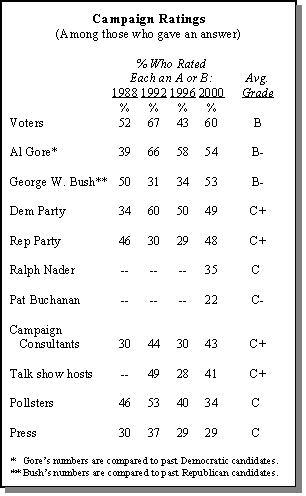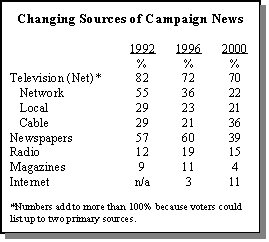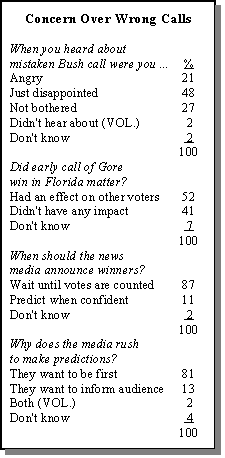Voters Trump Candidates

In addition to evaluating the campaign process, voters were asked to rate the various players in the campaign. When stacked up against the candidates, the parties and the media establishment, the voters themselves come out on top. More than one-in-five give voters an A, up dramatically from 12% in 1996. In 1996, Bill Clinton came out on top. This time, the voters trump both candidates.
Interestingly, Gore supporters rate themselves more highly than do Bush supporters — 62% vs. 46% A or B. However, when it comes to rating their candidates, Bush voters give their candidate slightly higher marks than Gore voters: 85% of Bush supporters give the Texas governor an A or B vs. 80% of Gore supporters who rate the vice president that highly.
Overall, Gore receives A’s and B’s from 54% of voters, while Bush gets similar grades from 53%. Ralph Nader and Pat Buchanan receive relatively low marks. Just over one-third of voters (35%) give Nader a grade of A or B; only 22% grade Buchanan A or B. Nader’s grades are higher than those received by Ross Perot in 1996, though much lower than Perot’s 1992 grades. Neither of the third-party candidates fared significantly better among political independents.
Voters give the Republican Party much higher grades for its performance in this campaign than they did in 1996. This year, 48% of voters give the GOP an A or B, compared to only 29% in 1996. The biggest improvement for the party has come from GOP loyalists themselves. In 1996, only 42% of Republicans gave their party an A or B; this year 76% did so. Evaluations of the Democratic Party have remained much more stable. About half of the voters polled give the Democrats an A or B, basically unchanged from four years ago.
Reflecting, perhaps, voters’ satisfaction with the quality and tone of this year’s campaign, the grades given to campaign consultants rose from 30% A or B in 1996 to 43% this year. Talk show hosts also improved their standing from 1996. Ratings for the pollsters, on the other hand, continue on a downward trajectory: 34% rate them A or B this year, down from 40% in 1996 and 53% in 1992.
The press winds up at the bottom of the heap, with only 29% giving them high marks for their performance. As many as one-in-five voters give the press a failing grade, a higher percentage than for any other group or person rated. Republicans are by far the most critical of the press, with only 20% giving them an A or B and 27% giving them as F. The press receives high grades from 39% of Democrats and failing grades from only 10%.
Cable Outranks the Networks

For the first time in a presidential campaign, more voters cite cable news outlets as a primary source of information about the campaign than either network or local television news. More than one-third of voters (36%) say they got most of their news from cable, compared to 22% for the networks and 21% for local television. Since the 1996 campaign, cable has increased by 15%, while the networks have declined by 14%.
Television, broadly defined, remains the leading source of election-related news. Seven-in-ten voters cite either cable, network and/or local news as a primary source of election news, down from 72% in 1996 and 82% in 1992.
There has been a precipitous decline in the number of voters relying on newspapers as a major source of campaign news. Fewer than four-in-ten (39%) say they got most of their news about the presidential campaign from newspapers, down from 60% in 1996. This falloff has occurred across all demographic groups, although it has been somewhat more pronounced among well-educated voters, who traditionally have been steadfast newspaper readers.
In 1996, 70% of college graduates cited newspapers as a major source of campaign news, compared to only 54% of those who had no more than a high school degree. This education gap has narrowed considerably. Today, newspapers are cited as a major source of election news by just 46% of college graduates, compared to 37% of voters with no more than a high school degree.
More Go Online for Election News
In place of traditional media sources, voters are increasingly going online for election information. Roughly 11% of voters list the Internet as one of their primary sources of campaign news, and another 19% say they got at least some of this news from the Internet. The overall total of 30% citing the Internet as a source for election news is three times the 1996 level.
Though Internet use has risen across the population, more educated and wealthier voters have been the most ready to take advantage of this new resource. Fully 37% of college graduates got at least some news about the campaign from the Internet, compared to just 22% of those with a high school degree or less. More than four-in-ten (42%) of those in households with annual incomes of $50,000 or more say they went online for campaign news, compared to only 15% of those in households with incomes of less than $20,000 annually.
Age is another factor associated with Internet use. Four years ago, 16% of voters under 30 got at least some campaign news online, compared to only 1% of those over age 65. Though there have been increases in Internet use among all voters, the disparity between young and old still exists. During the 2000 campaign, 42% of voters under 30 say they went online for campaign news, compared to only 10% of seniors.
The digital divide for election news is based more on age and income than race. While three-in-ten white voters say they went online to learn something about the election, almost as many African-American voters (28%) say the same.
Too Much Media Influence

Along with changing media habits, the 2000 election has also been marked by increasing concerns about the news media’s influence. For the first time, a majority of voters (53%) feel that news organizations exerted too much influence on the outcome of this year’s presidential election.
Republicans and Bush supporters are particularly unhappy with the press’ role in the election, with nearly two-thirds (63%) of each group saying the media has excessive influence, compared to 43% of Gore supporters and 42% of Democrats.
Some of this dissatisfaction is evidently linked to perceptions of media fairness in covering the candidates. Overall, 71% of voters feel the press was fair in the way it covered Gore’s election campaign, and 65% say the press was fair to Bush.
But as has been the case in the past, Republicans are less satisfied with press coverage, and more likely to perceive a press bias against their candidate. For many Republicans, perceptions of press bias go beyond the media’s treatment of their candidate. Less than half of Republicans (47%) believe that news organizations have been fair to both candidates this year, compared to 68% of Democrats. While 23% of Republicans say coverage was only fair to Gore, another quarter say the press was unfair to both candidates in covering the campaign.
High Interest, Deep Concern

Both voters’ interest in the campaign and dissatisfaction with the news media can be seen in their reactions to election coverage. Fully 88% of voters said they followed the returns on election night, with over 40% staying up past 1:00 AM Eastern Time, and 18% still watching at 3:00 AM Eastern Time — late enough to see the networks declare a Bush victory.
Regardless of how late they stayed up, most voters turned thumbs down on the media’s performance on that chaotic night. While there was widespread anger and disappointment over the networks’ erroneous call of a Bush victory, a majority say the earlier, mistaken call of a Gore win in Florida may have affected voters elsewhere. Republicans were particularly concerned about the early call of Florida for Gore — 62% felt it affected voters in other parts of the country compared to only 42% of Democrats. Republicans and Democrats were equally unhappy with the late night call of Florida for Bush.
Voters are nearly united with respect to the issue of when news organizations should announce the winners in the states By nearly an eight-to-one margin, they say the media should wait until nearly all the votes are counted, rather than predicting a winner when they feel confident about the outcome based on early returns.
Almost as many voters question the media’s motives for making early election calls. The vast majority (81%) says the main reason news organizations sometimes make projections too quickly is because they want to be the first to call the winner, not because they feel it is important for their audience to know the outcome as soon as possible.




